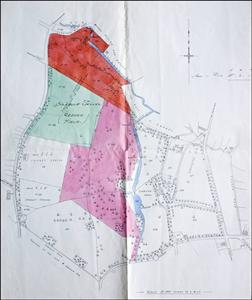After Reeves purchased Charlton Park in 1922 it is not known if he lived in the house and he may have had occasional tenants between 1922 and 1935, when it became Charlton Park Convent School. During this period Reeves offered to sell the house and park to Cheltenham College but they declined his offer. We know that the lawns were used for local fetes and other public functions during this period because photographs of such events exist. By 1929/30 Reeves was being pressed to sell some of the parkland for building development, but declined, preferring to wait for the right kind of purchaser to come along, and clearly favouring a religious or scholastic organization above all others. Reeves ensured that the fabric of the building did not deteriorate and some of his refurbishment work included plastering and painting the east front c1932. In 1931 Reeves sold his old College a further 25½ acres of Old Park (the land on the west side of Lilley Brook) at £200 per acre for £5,100, a figure well below its intrinsic or commercial value, contributing a quarter of it (£1,275) himself. The lawyer in him initiated the attachment of 11 restrictive covenants to the conveyance, which amongst other things stipulated:
'No building to be erected other than a private or professional dwelling house with the appropriate offices, motor house, stabling, summerhouse, garden shed and outbuildings'.
'One house only to be erected on each plot to the value of at least £1,200 [then quite a substantial sum] and approval of the college to be first obtained'.
'No trade, business, calling or occupation is to be carried on, other than that of doctor, dentist, solicitor barrister or architect surveyor or professional accountant without previous consent'.
'Nothing which in the opinion of the College may be or become a nuisance, damage or annoyance to or to the prejudice of the College or the owners lessees or occupiers of any lands or premises in the neighborhood to be permitted'.
'No digging or removal of sand chalk stone clay flint stone or soil except to prepare foundations'.
'Not to fell timber without consent of the college'.
In 1935 he amended the covenants in relation to the rest of the parkland (the construction of the first houses in Charlton Park Gate now being underway) by inserting another one:
'No buildings or erections other than dwelling houses or building for scholastic or religious purposes and no house of a less value than £1000 to be erected'.
Whilst today some of us might see this as the remnants of privileged, class-rooted self-interest, it should be remembered that at this pivotal moment in Charlton Park's history, a less careful benefactor could easily have omitted such restraints. Had that occurred we might now be commenting adversely on the presence of another sprawling, edge-of-town shopping centre, trade park or industrial estate sited in a treeless expanse of historic parkland, or worse still, peering into a hole after a major part of the park was scoured away by quarrying. In 1982/3 oral accounts were still on the lips of Charlton Park's modern residents (reaching my ears) that sand-quarrying had been seriously contemplated, sitting as the park does above some three metres of Cheltenham sand - the superficial geological deposit lying above the Cotswold Lias clay, and it may only have been Reeves' Covenants that prevented this from happening, except for his carefully worded exemption: 'except such as may be necessary in excavation the foundations of any buildings..........' The covenants were duly transferred by Cheltenham College to Bovis Homes Western Ltd on 7 January 1976 and after amendments by Bovis Homes, to each and every house-owner living in Charlton Park today. Even so, some individuals living nearby decried the fact that any house-building whatsoever had been permitted on the former parkland, and could be heard expressing such views quite forcibly in the 1980s.
 © Cheltenham CollegeThis plan was prepared whilst Hugh W Reeves owned Charlton Park (1922-1935) during which time he sold a portion of land along the S.W., abutting Claypits Path, for the building of high status houses in Charlton Park Gate.
© Cheltenham CollegeThis plan was prepared whilst Hugh W Reeves owned Charlton Park (1922-1935) during which time he sold a portion of land along the S.W., abutting Claypits Path, for the building of high status houses in Charlton Park Gate.
Hugh Reeves sold 25½ acres (shaded purple) to Cheltenham College in 1931 and this area is
almost identical to that sold by Cheltenham College to Bovis Homes Western Ltd in 1975
After Sandford Mill ceased milling in 1911 the red area formed part of William Cox's small Farm. In 1957 William's son, George Cox, sold the farm for £2,500. The land north of the River Chelt was then developed for housing and the meadow to the south of the River Chelt (Cox's Meadow) became public open space.
